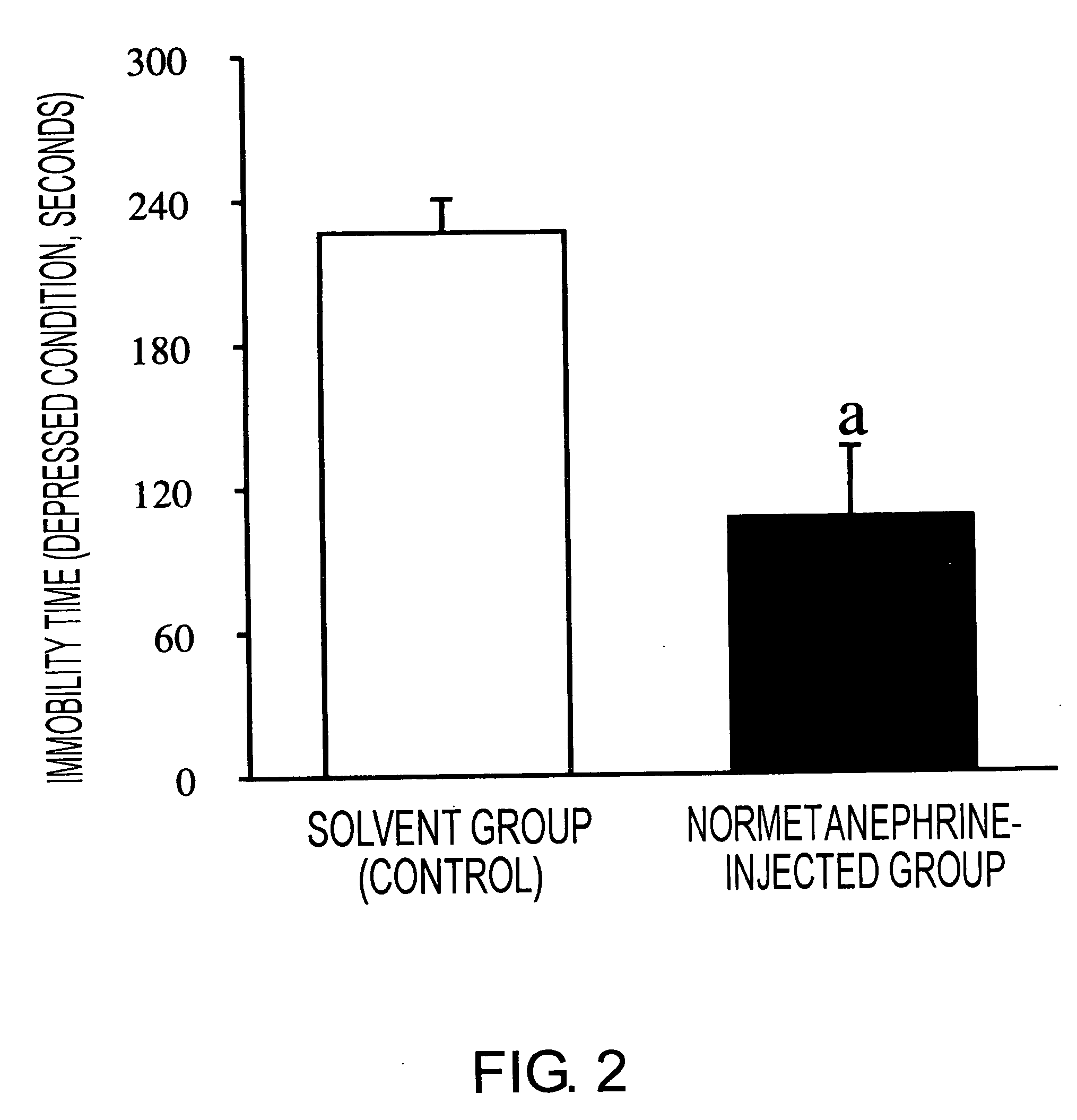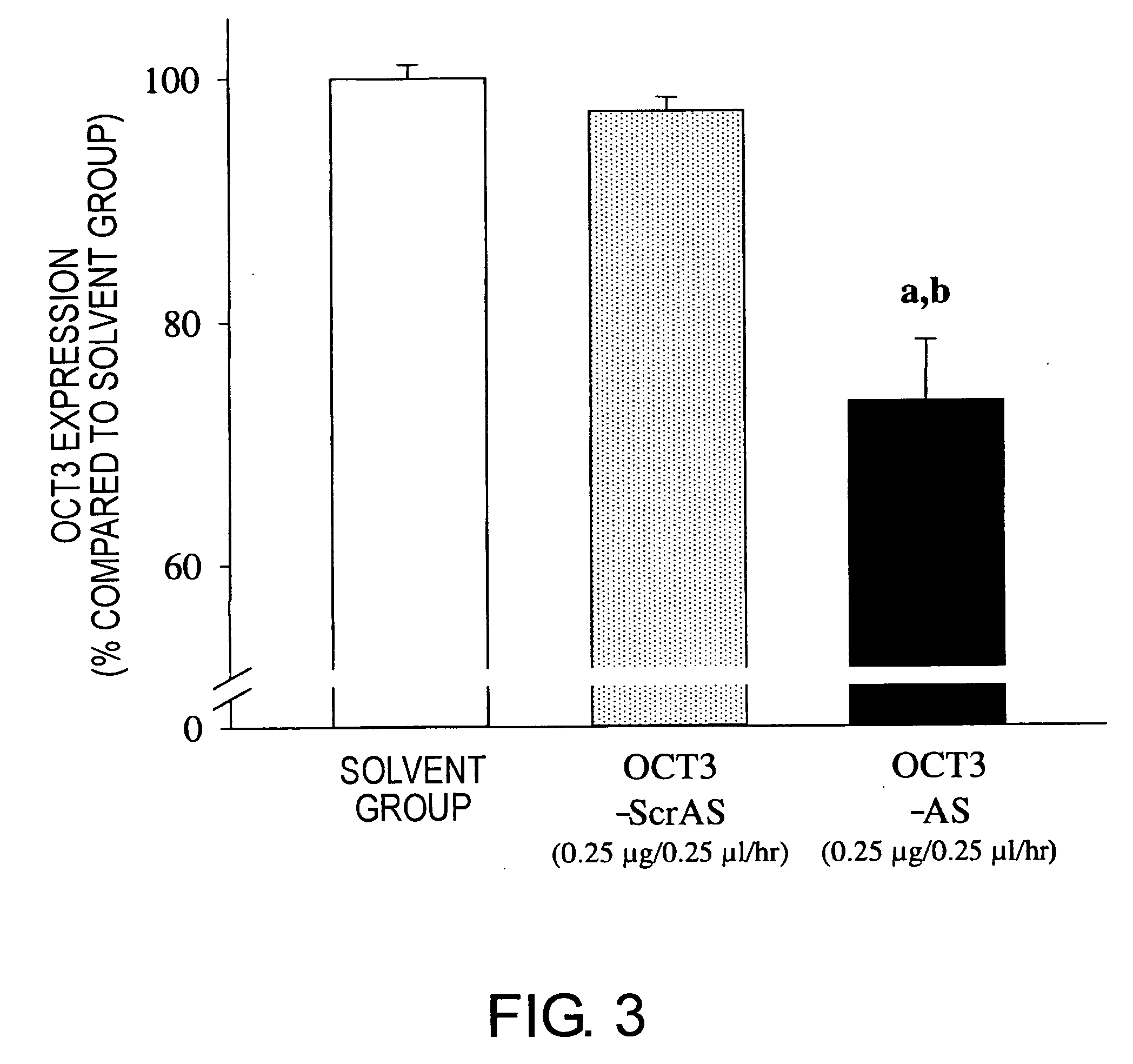Methods of using molecules related to organic cation transporter 3 (oct3) for treating depression, anxiety neuroses, drug dependencies, and other similar mental disorders
a technology of organic cation transporter and oct3 is applied in the field of use of the organic cation transporter oct3 for the treatment of mental disorders, which can solve the problems of lack of progress in research relating to oct3 and futile evaluation of the function of oct3 in the central nervous system, and achieve the effect of suppressing oct3 gene expression and enhancing the effect of anti-depressants
- Summary
- Abstract
- Description
- Claims
- Application Information
AI Technical Summary
Benefits of technology
Problems solved by technology
Method used
Image
Examples
example 1
Effect of the Regulation of OCT3 Expression on Depression-Like Symptoms
[0200] When experimental animals that has been made to swim in containers that prevented them from touching the bottom and from crawling out are made to swim again in the same container, they fall into despair and exhibit immobility for most of the experiment time. This condition of immobility is shortened by the administration of anti-depressants (example: chlordiazepoxide 100 mg / kg, imipramine 16 mg / kg), and therefore the present experiment (a forced swimming test) is often applied when screening for anti-depressants (Behav Brain Res. 73, 43-46, 1996). Thus, in this model the present inventors studied the effect of regulating OCT3 expression and its combined use with imipramine, an anti-depressant.
[0201] Male ddY mice were used for the experiments. Mice raised for three or more days after purchase were made to swim for 300 seconds in a beaker (15 cm in diameter, 20 cm in height). Immobility time was measured,...
example 2
The Effect of OCT3 Expression Regulation on Drug Dependency-Like Symptoms
[0206] Continuous use of psychostimulants causes the development of dependency, and symptoms include increased sensitivity (reversed tolerance) to psychostimulants. The reversed tolerance phenomenon is sustained for long periods of time and reappears readily in spite of a long-term withdrawal after continuous use of psychostimulants. It cannot be treated with existing therapeutic drugs for mental disorders, and is therefore considered to be the result of irreversible changes in neuronal function. An increase in psychostimulant-dependent spontaneous locomotor activity is observed upon repeated administration of psychostimulants in experimental animals, and this phenomenon cannot be treated with existing therapeutic drugs for mental disorders. Therefore, increased psychostimulant-induced spontaneous locomotor activity caused by the repeated administration of psychostimulant in experimental animals is often used ...
example 3
The Effect of OCT3 Expression Regulation on Anxiety and Exploratory Behaviors in New Places
[0209] Animals show exploratory behaviors (ambulation and rearing behaviors) when exposed to new, open spaces; however, such behaviors are reduced as time passes. Since such behaviors are diminished upon administration of anti-anxiety drugs and the animals maintain their exploratory behaviors, they can be used for screening anti-anxiety drugs. Therefore, in the present model the present inventors studied the effect of regulating OCT3 expression.
[0210] Male ddY mice were used in the experiments. Mice raised for three days or more were divided into two groups. The cerebral ventricles of one group were continuously infused with antisense (OCT3 antisense), constructed from an OCT3 gene sequence, using an osmotic pump according to the reported literature (J. Chem. Neuroanat. 2000. 20: 375-87). Another group was subjected to pseudosurgery. One week after the infusion the animals were placed in new...
PUM
| Property | Measurement | Unit |
|---|---|---|
| diameter | aaaaa | aaaaa |
| diameter | aaaaa | aaaaa |
| immobility time | aaaaa | aaaaa |
Abstract
Description
Claims
Application Information
 Login to View More
Login to View More - R&D
- Intellectual Property
- Life Sciences
- Materials
- Tech Scout
- Unparalleled Data Quality
- Higher Quality Content
- 60% Fewer Hallucinations
Browse by: Latest US Patents, China's latest patents, Technical Efficacy Thesaurus, Application Domain, Technology Topic, Popular Technical Reports.
© 2025 PatSnap. All rights reserved.Legal|Privacy policy|Modern Slavery Act Transparency Statement|Sitemap|About US| Contact US: help@patsnap.com



